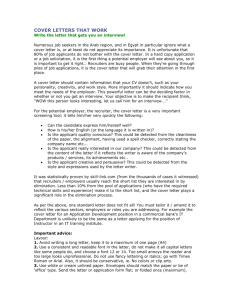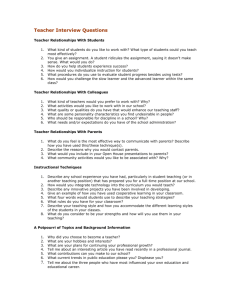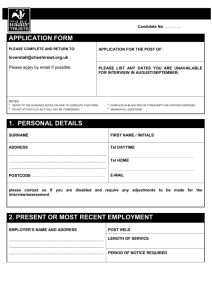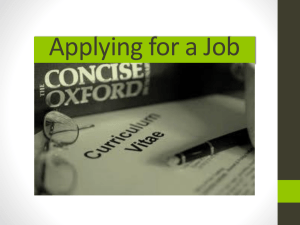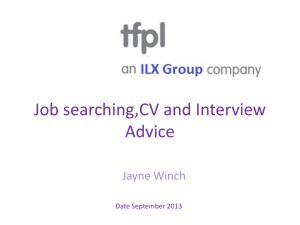Your CV Your style Your job
advertisement
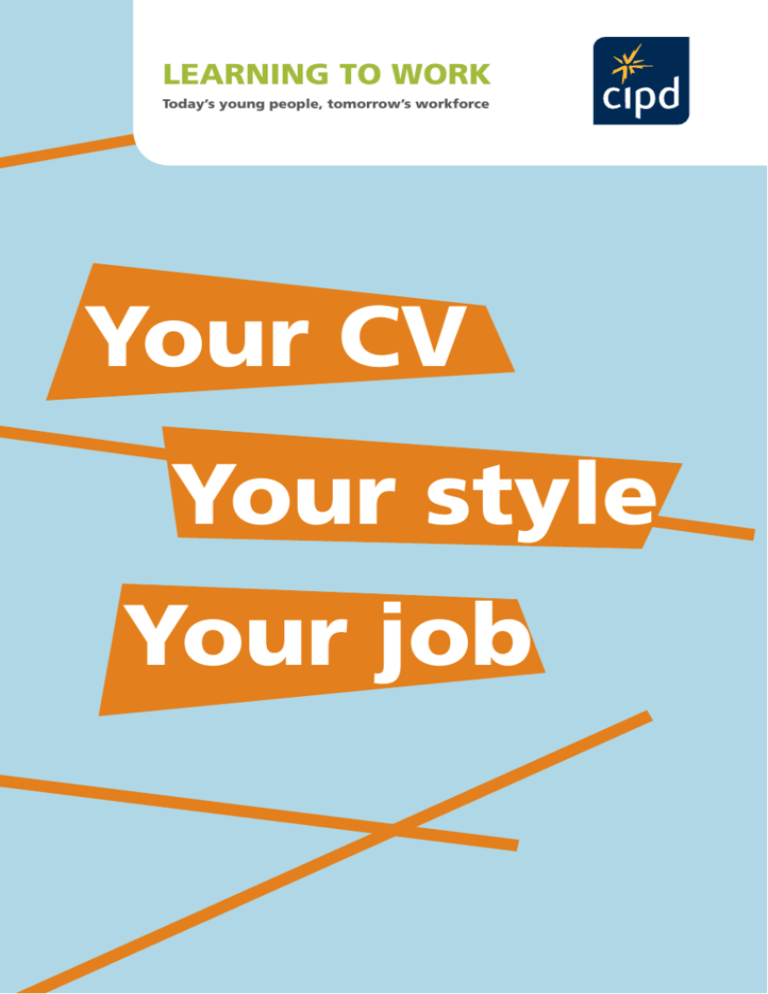
LEARNING TO WORK Today’s young people, tomorrow’s workforce Your CV Your style Your job Your CV guide This guide is designed to help you create your perfect CV, apply for a job and secure an interview. Unlike all of the CV advice websites that are available, this guide is personal to you. We won’t supply you with a standard template that employers are so used to seeing, but we will help you create a CV that shows who you are as an individual and that stands out from the crowd. Section 1: What is a CV and why do I need one? What you need to put in your CV and what you don’t How to write your first ever CV and stand out Those important changes to your current CV to make you stand out Section 2: Covering letters Completing application forms Section 3: Interview stage What to do next Your interview – dos and don’ts Congratulations, you’ve got the job! n1 Sectio What is a CV and why do I need one? •Your CV is a piece of work completed by you, almost like a sales pitch on a sheet of paper. •Your CV is used to show a potential employer that you have the right experience (not just paid work experience) and the ability to perform. It shows the skills you can bring to their company, your motivation to succeed and highlights that you are the type of employee they are looking to recruit for that particular job. •Your CV should be a maximum of two pages long. A potential employer doesn’t want pages of information about you. Make sure you put the important things right at the beginning. If your CV is too long, the employer won’t have time to read it. •Print out your CV on quality paper. And make sure that you save your CV on your computer so that it’s ready for any other applications. •Use a font size no smaller than 10pt and use a normal font such as Arial or Times New Roman. If an employer can’t read about you, they won’t want to meet you! •Use simple, plain and positive English with clear and concise content – don’t waffle! •Check the spelling and grammar before sending your CV to employers. If you are unsure of how to spell a word, use a dictionary to check it. Have a family friend or neighbour check that your whole CV reads well – a fresh pair of eyes will spot any small errors that you may have missed. • There are hundreds of websites that will tell you how to lay out your CV, but they are all the same and employers have seen dozens of these. The layout should be easy to read and nice to look at. Look at a ‘standard CV template’ online and then use your own touch to make yours different. Don’t use fancy borders because this will take the focus away from the important parts. 2 What you need to put in your CV and what you don’t Contact details Dos •Your full name should be at the top of the page (not the nickname that your mates use!). •Full home address including postcode (if you don’t know it, Google will). •Mobile phone number and home telephone number if possible – give the employer some different contact options. •Email address – make sure this is appropriate (using an email such as juiceylucy@gotmail. co.uk is not acceptable and employers will sift you out straight away). Don’ts •Driving licence – you don’t need to put down that you hold one (unless you are applying for driving jobs). •Photograph – unless you are applying to be Britain’s next top model, an employer won’t need to know what you look like. •Date of birth – unless you are applying to work with alcohol, this is also not needed. Mini profile •This is the most important and useful part of your CV because it highlights you as a candidate and why you are different from the rest. •Make it either a short and snappy paragraph, or use bullet points highlighting your best skills. •Ask someone to check it for you or, better still, get someone you know to give you a few points on the type of person you are; this should help you highlight your best personal qualities. Key skills and achievements • If you have any achievements (certificates) that are relevant to the job for which you are applying, list them. For example, if you are applying for a waitressing role and have a food hygiene certificate, put that down because the employer will be keen to see it (don’t forget the dates that you completed the certificate). • If you don’t have any relevant achievements, it’s nothing to worry about. You can leave this section out. Career history •List your most recent job, work experience or voluntary work first and work your way back. Employers will want to see your up-to-date employment at the top. •Don’t forget to list your main responsibilities, your job title and the dates you were employed. •Make sure that the dates all match up; this is something that an employer will look at and, if there are gaps, make sure you can explain them. •Don’t make up tasks to make yourself look better. Be honest! Training and education •List your education (school, college or university) as additional to any others you have put in the key skills and achievements section. •If you have done training with previous employment, for example customer service, list this as well because it will show a new employer that you are willing to learn. •If you have any outside of work skills, for example public speaking at a local community group, include these also because it shows your commitment. 3 Interests and hobbies •These may sometimes be used as an ‘ice breaker’ if you are called for an interview, so make sure that they are genuine interests. •Put relevant hobbies to the job for which you are applying, for example cooking if you are applying for a chef’s role (things such as socialising with friends are not relevant). •Make sure that you have examples to back your hobbies up if called for an interview. References • Not required on your CV – they will only take up unnecessary space. The best thing to say is: ‘References available on request.’ How to write your first ever CV and stand out When you write your first CV, don’t worry if you haven’t got any work experience. There are plenty of other ways to show employers that you have the right skills and abilities to work for them and highlight that you are the best candidate for their company. School • Were you part of a club or group at school/college/university where you had responsibilities? • Did you have to organise school/college/university events? Did you have to keep records? Hold meetings? If so, these are perfect examples of being organised, working in a group, using your initiative and sticking to deadlines. Awards • Have you taken part in any Duke of Edinburgh Awards or similar? These are also examples that you have worked within a team and followed instructions. Voluntary • Have you done any voluntary work? Girl Guiding? Local charity shops? Local elderly home? Helped at a local church group? These are good examples to use as well. All of the above will show that you are able to complete tasks, work with other people and are a committed individual. Those important changes to your current CV to make you stand out •Having more than one CV is perfectly normal because most jobs for which you apply are completely different from the last, and you will need to amend your CV to suit each job. •If you are applying for a job that requires a specific skill, for example gardener, make sure that you highlight this skill – you have to show that you are capable. •Take out any unnecessary skills. This will take up space and the employer won’t want to know about things that aren’t relevant to their vacancy. •Use the job description for the vacancy. If you don’t have one, look at the company’s website or use any brochures you can find. This will help you to establish the kind of candidates that particular company is looking for. •Think about what you have to offer to the specific employer – how are you different from the rest? •Use words from the job advert and put these in your CV. This can also be included in your covering letter. This will prove that you have read the advert properly and paid attention to detail. 4 n2 Sectio This section is designed to help you with the next stages of your CV and what you should do before sending it to potential employers. Covering letters •The purpose of a covering letter is to market yourself and your skills. •Just like your CV, you will need to amend each covering letter for each job for which you apply to make it suit that particular employer. •A covering letter gives you the opportunity to get recruiters interested in you and your CV, so every CV needs a letter! •Have a ‘draft’ copy saved on your computer so you can adapt it each time you apply for a job. •Make sure your spelling and grammar is correct. If an employer spots an error, they won’t look at your CV. What to include in your covering letter •Address it to a named person if possible, if not use ‘Dear Sir/Madam’. •Tell them why you are writing to them. •Explain what interests you about the job. •Point out your key skills, experience and/or qualifications that are relevant to that particular job. •Explain why you want to work for the company and what you can bring as an individual. •End the letter with a positive, expressing your willingness to discuss your application at interview. Style of your covering letter •Make sure the letter is typed and is in the same font and size as your CV. •One page of A4 only – it doesn’t need to be too long. •Three or four paragraphs are acceptable. •Keep to the point – don’t waffle. •End the letter with ‘Yours faithfully’ or ‘Yours sincerely’ and sign your name. Completing application forms When you are completing an application form, whether it’s online or in a paper format, you must make sure that you check it thoroughly before sending it. Why not get someone to check it for you? Once it’s been sent, there are no chances to change it. Online application forms Companies may ask you to register yourself on their website and apply for their vacancy online. This is becoming more and more popular, so you need to make sure that you complete all sections before you press the submit button. • Check your online application form for spelling and grammar before sending it. If you are unsure of how to spell a word, use a dictionary to check it because not all sites will have a spell-check facility. •If you are having problems submitting your application, don’t just hope for the best. There is always a helpline number or email address to contact. This will ensure that your application is received properly and on time. •The company will probably have a lot of online applications to sift through, so you need to make sure that yours will stand out from the other applicants’. 5 •Use the contents from your CV to complete any ‘skills’ section. •Don’t forget about the draft covering letter you have written. It’s a good idea to use this on any additional information spaces that the online application has. n3 Sectio Interview stage You’ve had a call to say, ‘We’d like to see you for an interview.’ This is great news and you’re a step closer to obtaining the job you want. This is proof that the hard work you have put into your CV has paid off and that you stood out from lots of other applicants. Your interview invite will normally be followed up by a confirmation email or letter, so make sure that you read this thoroughly and take it with you on the day. What to do next •Prepare for your interview to make sure it goes well and you can show you are the best person for the job. •Make sure that you know where to go for your interview. •Plan your journey so that you are not late. Completing a ‘trial run journey’ is a good idea. •How are you going to get there? If you are driving, can you use the company car park or is there one close by that you need to use? If you are going by bus, do you know where the bus stops? •Do you need to confirm your attendance for the interview? This will be stated on the letter they have sent you, so make sure you read it fully. Your interview – dos and don’ts •Do – arrive on time – 10 minutes early will really impress them. •Do – take a pad and pen with you, in case you feel you need to note down any information. •Do – take a copy of your CV and your interview letter with you. •Do – dress appropriately. Make sure you are smart and cover up any offensive tattoos. •Do – be yourself. •Do – ask questions about the role – this will show that you are interested. •Do – research the company – there is a chance they may ask you questions about it and what interests you about working for them. •Don’t – leave your phone switched on. Put it on silent and don’t answer it. •Don’t – turn up underdressed and scruffy. •Don’t – make things up to make yourself look good. •REMEMBER – Shake the interviewer’s hand as soon as you greet them, make eye contact and SMILE! Congratulations, you’ve got the job! Getting the job you really want is even more proof that your hard work has paid off. Don’t forget to prepare for your first day, dress appropriately and ask questions if you need to – there will be a lot to learn on your first day. This is the start of something exciting for you. Good luck with your new career! 6 Learning to work How to make the transition from education to work Today, many young people struggle with making the transition from education into work. Finding employment takes longer and is more difficult. This is partly, of course, due to the recession and to fewer jobs being available. However, the labour market is also changing in a way that disadvantages young people. Many employers prefer to recruit workers with more experience, there is a decline in entry-level jobs and there are fewer access routes into organisations. Furthermore, technological changes and globalisation mean that the labour market has become more complex and more difficult to navigate for young people. We think young people need all the help they can get, which is why the CIPD has launched its Learning to Work campaign, which aims to harness the support of our 135,000 members, responsible for the employment, management and development of a large part of the UK’s workforce, for young people as they take their first steps on the career ladder. We want to encourage HR professionals and employers to help prepare young people for work. But we’d also like them to make the world of work more youth friendly by providing more and better access routes for young people into their organisations and to see the business case for engaging with and investing in young people to build the skills for the future. Part of the practical actions of our Learning to Work campaign is our mentoring initiative Steps Ahead Mentoring, which matches our members, HR professionals, with jobseekers to give them advice and guidance on CV writing, interview techniques and job-searching generally. This CV guide is an important part of the initiative, but ideally we’d like young people to have the same level of support before they enter the labour market, to help smooth the transition from education to work. Our support for Inspiring the Future is part of this campaign and we will work with The Education and Employers Taskforce to promote this guide and to encourage our members to help provide young people with insights on recruitment issues. Katerina Rüdiger, Skills Policy Adviser, CIPD LEARNING TO WORK Today’s young people, tomorrow’s workforce 7 Steps Ahead Mentoring The CIPD has set up a mentoring project that matches young jobseekers with our members, who are HR professionals. The project is designed to improve young jobseekers’ employability and bring them closer to the labour market. Steps Ahead Mentoring was started as a pilot in August 2011 and, due to the ongoing support, hard work and commitment from our mentors and the young people, we are now able to expand the good work across the UK. We have an expansion plan in place and we are confident that in a year’s time we will have helped thousands of young people to improve their employability skills and potentially come off Job Seekers Allowance. By working in partnership with Jobcentre Plus, the CIPD is able to match unemployed people aged 18–24 to local CIPD members who have volunteered their time as a mentor. The Jobcentre advisers are the first point of contact with the young person, and it is their responsibility to encourage the young person to take part, providing the young person as a suitable candidate. The advisers refer the young people to the CIPD’s project team, who then match them to one of the volunteer mentors within seven days. This guide has been produced as a tool for our mentors to support their matched young person in their job search; it is also designed to help a young person create a CV that could find them employment. The author of this guide would like to thank all of the mentors for their feedback and for giving their time to help young people with their employability and in navigating the labour market. Kelly Duncan, Project Executive, Steps Ahead Mentoring and author of this guide. R O T N E M Steps Ahead Mentoring Chartered Institute of Personnel and Development 151 The Broadway London SW19 1JQ UK Tel: +44 (0)20 8612 6200 Fax: +44 (0)20 8612 6201 Email: cipd@cipd.co.uk Website: cipd.co.uk Incorporated by Royal Charter Registered charity no.1079797 Issued: July 2012 Reference: 5905 © Chartered Institute of Personnel and Development 2012 Once contact has been made between the mentor and young person, they will meet for an average of six sessions to work on such things as CV writing, interview techniques and selfconfidence.


